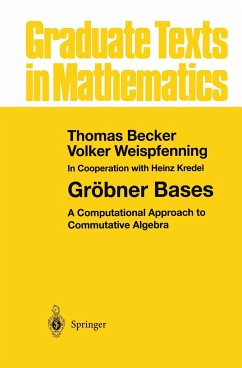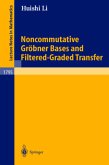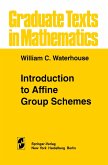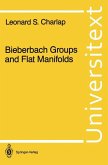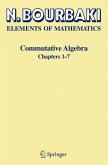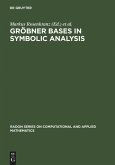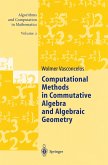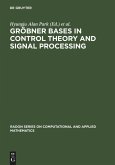- Gebundenes Buch
- Merkliste
- Auf die Merkliste
- Bewerten Bewerten
- Teilen
- Produkt teilen
- Produkterinnerung
- Produkterinnerung
The origins of the mathematics in this book date back more than two thou sand years, as can be seen from the fact that one of the most important algorithms presented here bears the name of the Greek mathematician Eu clid. The word "algorithm" as well as the key word "algebra" in the title of this book come from the name and the work of the ninth-century scientist Mohammed ibn Musa al-Khowarizmi, who was born in what is now Uzbek istan and worked in Baghdad at the court of Harun al-Rashid's son. The word "algorithm" is actually a westernization of al-Khowarizmi's name, while "algebra" derives…mehr
Andere Kunden interessierten sich auch für
![Noncommutative Gröbner Bases and Filtered-Graded Transfer Noncommutative Gröbner Bases and Filtered-Graded Transfer]() Huishi LiNoncommutative Gröbner Bases and Filtered-Graded Transfer35,99 €
Huishi LiNoncommutative Gröbner Bases and Filtered-Graded Transfer35,99 €![Introduction to Affine Group Schemes Introduction to Affine Group Schemes]() W.C. WaterhouseIntroduction to Affine Group Schemes65,99 €
W.C. WaterhouseIntroduction to Affine Group Schemes65,99 €![Bieberbach Groups and Flat Manifolds Bieberbach Groups and Flat Manifolds]() Leonard S. CharlapBieberbach Groups and Flat Manifolds38,99 €
Leonard S. CharlapBieberbach Groups and Flat Manifolds38,99 €![Commutative Algebra Commutative Algebra]() N. BourbakiCommutative Algebra51,99 €
N. BourbakiCommutative Algebra51,99 €![Gröbner Bases in Symbolic Analysis Gröbner Bases in Symbolic Analysis]() Gröbner Bases in Symbolic Analysis149,95 €
Gröbner Bases in Symbolic Analysis149,95 €![Computational Methods in Commutative Algebra and Algebraic Geometry Computational Methods in Commutative Algebra and Algebraic Geometry]() Wolmer VasconcelosComputational Methods in Commutative Algebra and Algebraic Geometry53,99 €
Wolmer VasconcelosComputational Methods in Commutative Algebra and Algebraic Geometry53,99 €![Gröbner Bases in Control Theory and Signal Processing Gröbner Bases in Control Theory and Signal Processing]() Hyungju Alan Park / Georg Regensburger (eds.)Gröbner Bases in Control Theory and Signal Processing122,99 €
Hyungju Alan Park / Georg Regensburger (eds.)Gröbner Bases in Control Theory and Signal Processing122,99 €-
-
-
The origins of the mathematics in this book date back more than two thou sand years, as can be seen from the fact that one of the most important algorithms presented here bears the name of the Greek mathematician Eu clid. The word "algorithm" as well as the key word "algebra" in the title of this book come from the name and the work of the ninth-century scientist Mohammed ibn Musa al-Khowarizmi, who was born in what is now Uzbek istan and worked in Baghdad at the court of Harun al-Rashid's son. The word "algorithm" is actually a westernization of al-Khowarizmi's name, while "algebra" derives from "al-jabr," a term that appears in the title of his book Kitab al-jabr wa'l muqabala, where he discusses symbolic methods for the solution of equations. This close connection between algebra and al gorithms lasted roughly up to the beginning of this century; until then, the primary goal of algebra was the design of constructive methods for solving equations by means of symbolic transformations. During the second half of the nineteenth century, a new line of thought began to enter algebra from the realm of geometry, where it had been successful since Euclid's time, namely, the axiomatic method.
Hinweis: Dieser Artikel kann nur an eine deutsche Lieferadresse ausgeliefert werden.
Hinweis: Dieser Artikel kann nur an eine deutsche Lieferadresse ausgeliefert werden.
Produktdetails
- Produktdetails
- Verlag: Springer New York / Springer US
- 1993
- Seitenzahl: 604
- Erscheinungstermin: 8. April 1993
- Englisch
- Abmessung: 241mm x 160mm x 37mm
- Gewicht: 1062g
- ISBN-13: 9780387979717
- ISBN-10: 0387979719
- Artikelnr.: 21789501
- Herstellerkennzeichnung
- Springer-Verlag GmbH
- Tiergartenstr. 17
- 69121 Heidelberg
- ProductSafety@springernature.com
- Verlag: Springer New York / Springer US
- 1993
- Seitenzahl: 604
- Erscheinungstermin: 8. April 1993
- Englisch
- Abmessung: 241mm x 160mm x 37mm
- Gewicht: 1062g
- ISBN-13: 9780387979717
- ISBN-10: 0387979719
- Artikelnr.: 21789501
- Herstellerkennzeichnung
- Springer-Verlag GmbH
- Tiergartenstr. 17
- 69121 Heidelberg
- ProductSafety@springernature.com
0 Basics.
0.1 Natural Numbers and Integers.
0.2 Maps.
0.3 Mathematical Algorithms.
Notes.
1 Commutative Rings with Unity.
1.1 Why Abstract Algebra?.
1.2 Groups.
1.3 Rings.
1.4 Subrings and Homomorphisms.
1.5 Ideals and Residue Class Rings.
1.6 The Homomorphism Theorem.
1.7 Gcd's, Lcm's, and Principal Ideal Domains.
1.8 Maximal and Prime Ideals.
1.9 Prime Rings and Characteristic.
1.10 Adjunction, Products, and Quotient Rings.
Notes.
2 Polynomial Rings.
2.1 Definitions.
2.2 Euclidean Domains.
2.3 Unique Factorization Domains.
2.4 The Gaussian Lemma.
2.5 Polynomial Gcd's.
2.6 Squarefree Decomposition of Polynomials.
2.7 Factorization of Polynomials.
2.8 The Chinese Remainder Theorem.
Notes.
3 Vector Spaces and Modules.
3.1 Vector Spaces.
3.2 Independent Sets and Dimension.
3.3 Modules.
Notes.
4 Orders and Abstract Reduction Relations.
4.1 The Axiom of Choice and Some Consequences in Algebra.
4.2 Relations.
4.3 Foundedness Properties.
4.4 Some Special Orders.
4.5 Reduction Relations.
4.6 Computing in Algebraic Structures.
Notes.
5 Gröbner Bases.
5.1 Term Orders and Polynomial Reductions.
5.2 Gröbner Bases
Existence and Uniqueness.
5.3 Gröbner Bases
Construction.
5.4 Standard Representations.
5.5 Improved Gröbner Basis Algorithms.
5.6 The Extended Gröbner Basis Algorithm.
Notes.
6 First Applications of Gröbner Bases.
6.1 Computation of Syzygies.
6.2 Basic Algorithms in Ideal Theory.
6.3 Dimension of Ideals.
6.4 Uniform Word Problems.
Notes.
7 Field Extensions and the Hilbert Nullstellensatz.
7.1 Field Extensions.
7.2 The Algebraic Closure of a Field.
7.3 Separable Polynomials and Perfect Fields.
7.4 The Hilbert Nullstellensatz.
7.5 Height and Depth of Prime Ideals.
7.6 Implicitization of RationalParametrizations.
7.7 Invertibility of Polynomial Maps.
Notes.
8 Decomposition, Radical, and Zeroes of Ideals.
8.1 Preliminaries.
8.2 The Radical of a Zero
Dimensional Ideal.
8.3 The Number of Zeroes of an Ideal.
8.4 Primary Ideals.
8.5 Primary Decomposition in Noetherian Rings.
8.6 Primary Decomposition of Zero
Dimensional Ideals.
8.7 Radical and Decomposition in Higher Dimensions.
8.8 Computing Real Zeroes of Polynomial Systems.
Notes.
9 Linear Algebra in Residue Class Rings.
9.1 Gröbner Bases and Reduced Terms.
9.2 Computing in Finitely Generated Algebras.
9.3 Dimensions and the Hilbert Function.
Notes.
10 Variations on Gröbner Bases.
10.1 Gröbner Bases over PID's and Euclidean Domains.
10.2 Homogeneous Gröbner Bases.
10.3 Homogenization.
10.4 Gröbner Bases for Polynomial Modules.
10.5 Systems of Linear Equations.
10.6 Standard Bases and the Tangent Cone.
10.7 Symmetric Functions.
Notes.
Appendix: Outlook on Advanced and Related Topics.
Complexity of Gröbner Basis Constructions.
Term Orders and Universal Gröbner Bases.
Comprehensive Gröbner Bases.
Gröbner Bases and Automatic Theorem Proving.
Characteristic Sets and Wu
Ritt Reduction.
Term Rewriting.
Standard Bases in Power Series Rings.
Non
Commutative Gröbner Bases.
Gröbner Bases and Differential Algebra.
Selected Bibliography.
Conference Proceedings.
Books and Monographs.
Articles.
List of Symbols.
0.1 Natural Numbers and Integers.
0.2 Maps.
0.3 Mathematical Algorithms.
Notes.
1 Commutative Rings with Unity.
1.1 Why Abstract Algebra?.
1.2 Groups.
1.3 Rings.
1.4 Subrings and Homomorphisms.
1.5 Ideals and Residue Class Rings.
1.6 The Homomorphism Theorem.
1.7 Gcd's, Lcm's, and Principal Ideal Domains.
1.8 Maximal and Prime Ideals.
1.9 Prime Rings and Characteristic.
1.10 Adjunction, Products, and Quotient Rings.
Notes.
2 Polynomial Rings.
2.1 Definitions.
2.2 Euclidean Domains.
2.3 Unique Factorization Domains.
2.4 The Gaussian Lemma.
2.5 Polynomial Gcd's.
2.6 Squarefree Decomposition of Polynomials.
2.7 Factorization of Polynomials.
2.8 The Chinese Remainder Theorem.
Notes.
3 Vector Spaces and Modules.
3.1 Vector Spaces.
3.2 Independent Sets and Dimension.
3.3 Modules.
Notes.
4 Orders and Abstract Reduction Relations.
4.1 The Axiom of Choice and Some Consequences in Algebra.
4.2 Relations.
4.3 Foundedness Properties.
4.4 Some Special Orders.
4.5 Reduction Relations.
4.6 Computing in Algebraic Structures.
Notes.
5 Gröbner Bases.
5.1 Term Orders and Polynomial Reductions.
5.2 Gröbner Bases
Existence and Uniqueness.
5.3 Gröbner Bases
Construction.
5.4 Standard Representations.
5.5 Improved Gröbner Basis Algorithms.
5.6 The Extended Gröbner Basis Algorithm.
Notes.
6 First Applications of Gröbner Bases.
6.1 Computation of Syzygies.
6.2 Basic Algorithms in Ideal Theory.
6.3 Dimension of Ideals.
6.4 Uniform Word Problems.
Notes.
7 Field Extensions and the Hilbert Nullstellensatz.
7.1 Field Extensions.
7.2 The Algebraic Closure of a Field.
7.3 Separable Polynomials and Perfect Fields.
7.4 The Hilbert Nullstellensatz.
7.5 Height and Depth of Prime Ideals.
7.6 Implicitization of RationalParametrizations.
7.7 Invertibility of Polynomial Maps.
Notes.
8 Decomposition, Radical, and Zeroes of Ideals.
8.1 Preliminaries.
8.2 The Radical of a Zero
Dimensional Ideal.
8.3 The Number of Zeroes of an Ideal.
8.4 Primary Ideals.
8.5 Primary Decomposition in Noetherian Rings.
8.6 Primary Decomposition of Zero
Dimensional Ideals.
8.7 Radical and Decomposition in Higher Dimensions.
8.8 Computing Real Zeroes of Polynomial Systems.
Notes.
9 Linear Algebra in Residue Class Rings.
9.1 Gröbner Bases and Reduced Terms.
9.2 Computing in Finitely Generated Algebras.
9.3 Dimensions and the Hilbert Function.
Notes.
10 Variations on Gröbner Bases.
10.1 Gröbner Bases over PID's and Euclidean Domains.
10.2 Homogeneous Gröbner Bases.
10.3 Homogenization.
10.4 Gröbner Bases for Polynomial Modules.
10.5 Systems of Linear Equations.
10.6 Standard Bases and the Tangent Cone.
10.7 Symmetric Functions.
Notes.
Appendix: Outlook on Advanced and Related Topics.
Complexity of Gröbner Basis Constructions.
Term Orders and Universal Gröbner Bases.
Comprehensive Gröbner Bases.
Gröbner Bases and Automatic Theorem Proving.
Characteristic Sets and Wu
Ritt Reduction.
Term Rewriting.
Standard Bases in Power Series Rings.
Non
Commutative Gröbner Bases.
Gröbner Bases and Differential Algebra.
Selected Bibliography.
Conference Proceedings.
Books and Monographs.
Articles.
List of Symbols.
0 Basics.- 0.1 Natural Numbers and Integers.- 0.2 Maps.- 0.3 Mathematical Algorithms.- Notes.- 1 Commutative Rings with Unity.- 1.1 Why Abstract Algebra?.- 1.2 Groups.- 1.3 Rings.- 1.4 Subrings and Homomorphisms.- 1.5 Ideals and Residue Class Rings.- 1.6 The Homomorphism Theorem.- 1.7 Gcd's, Lcm's, and Principal Ideal Domains.- 1.8 Maximal and Prime Ideals.- 1.9 Prime Rings and Characteristic.- 1.10 Adjunction, Products, and Quotient Rings.- Notes.- 2 Polynomial Rings.- 2.1 Definitions.- 2.2 Euclidean Domains.- 2.3 Unique Factorization Domains.- 2.4 The Gaussian Lemma.- 2.5 Polynomial Gcd's.- 2.6 Squarefree Decomposition of Polynomials.- 2.7 Factorization of Polynomials.- 2.8 The Chinese Remainder Theorem.- Notes.- 3 Vector Spaces and Modules.- 3.1 Vector Spaces.- 3.2 Independent Sets and Dimension.- 3.3 Modules.- Notes.- 4 Orders and Abstract Reduction Relations.- 4.1 The Axiom of Choice and Some Consequences in Algebra.- 4.2 Relations.- 4.3 Foundedness Properties.- 4.4 Some Special Orders.- 4.5 Reduction Relations.- 4.6 Computing in Algebraic Structures.- Notes.- 5 Gröbner Bases.- 5.1 Term Orders and Polynomial Reductions.- 5.2 Gröbner Bases-Existence and Uniqueness.- 5.3 Gröbner Bases-Construction.- 5.4 Standard Representations.- 5.5 Improved Gröbner Basis Algorithms.- 5.6 The Extended Gröbner Basis Algorithm.- Notes.- 6 First Applications of Gröbner Bases.- 6.1 Computation of Syzygies.- 6.2 Basic Algorithms in Ideal Theory.- 6.3 Dimension of Ideals.- 6.4 Uniform Word Problems.- Notes.- 7 Field Extensions and the Hilbert Nullstellensatz.- 7.1 Field Extensions.- 7.2 The Algebraic Closure of a Field.- 7.3 Separable Polynomials and Perfect Fields.- 7.4 The Hilbert Nullstellensatz.- 7.5 Height and Depth of Prime Ideals.- 7.6 Implicitization of RationalParametrizations.- 7.7 Invertibility of Polynomial Maps.- Notes.- 8 Decomposition, Radical, and Zeroes of Ideals.- 8.1 Preliminaries.- 8.2 The Radical of a Zero-Dimensional Ideal.- 8.3 The Number of Zeroes of an Ideal.- 8.4 Primary Ideals.- 8.5 Primary Decomposition in Noetherian Rings.- 8.6 Primary Decomposition of Zero-Dimensional Ideals.- 8.7 Radical and Decomposition in Higher Dimensions.- 8.8 Computing Real Zeroes of Polynomial Systems.- Notes.- 9 Linear Algebra in Residue Class Rings.- 9.1 Gröbner Bases and Reduced Terms.- 9.2 Computing in Finitely Generated Algebras.- 9.3 Dimensions and the Hilbert Function.- Notes.- 10 Variations on Gröbner Bases.- 10.1 Gröbner Bases over PID's and Euclidean Domains.- 10.2 Homogeneous Gröbner Bases.- 10.3 Homogenization.- 10.4 Gröbner Bases for Polynomial Modules.- 10.5 Systems of Linear Equations.- 10.6 Standard Bases and the Tangent Cone.- 10.7 Symmetric Functions.- Notes.- Appendix: Outlook on Advanced and Related Topics.- Complexity of Gröbner Basis Constructions.- Term Orders and Universal Gröbner Bases.- Comprehensive Gröbner Bases.- Gröbner Bases and Automatic Theorem Proving.- Characteristic Sets and Wu-Ritt Reduction.- Term Rewriting.- Standard Bases in Power Series Rings.- Non-Commutative Gröbner Bases.- Gröbner Bases and Differential Algebra.- Selected Bibliography.- Conference Proceedings.- Books and Monographs.- Articles.- List of Symbols.
0 Basics.
0.1 Natural Numbers and Integers.
0.2 Maps.
0.3 Mathematical Algorithms.
Notes.
1 Commutative Rings with Unity.
1.1 Why Abstract Algebra?.
1.2 Groups.
1.3 Rings.
1.4 Subrings and Homomorphisms.
1.5 Ideals and Residue Class Rings.
1.6 The Homomorphism Theorem.
1.7 Gcd's, Lcm's, and Principal Ideal Domains.
1.8 Maximal and Prime Ideals.
1.9 Prime Rings and Characteristic.
1.10 Adjunction, Products, and Quotient Rings.
Notes.
2 Polynomial Rings.
2.1 Definitions.
2.2 Euclidean Domains.
2.3 Unique Factorization Domains.
2.4 The Gaussian Lemma.
2.5 Polynomial Gcd's.
2.6 Squarefree Decomposition of Polynomials.
2.7 Factorization of Polynomials.
2.8 The Chinese Remainder Theorem.
Notes.
3 Vector Spaces and Modules.
3.1 Vector Spaces.
3.2 Independent Sets and Dimension.
3.3 Modules.
Notes.
4 Orders and Abstract Reduction Relations.
4.1 The Axiom of Choice and Some Consequences in Algebra.
4.2 Relations.
4.3 Foundedness Properties.
4.4 Some Special Orders.
4.5 Reduction Relations.
4.6 Computing in Algebraic Structures.
Notes.
5 Gröbner Bases.
5.1 Term Orders and Polynomial Reductions.
5.2 Gröbner Bases
Existence and Uniqueness.
5.3 Gröbner Bases
Construction.
5.4 Standard Representations.
5.5 Improved Gröbner Basis Algorithms.
5.6 The Extended Gröbner Basis Algorithm.
Notes.
6 First Applications of Gröbner Bases.
6.1 Computation of Syzygies.
6.2 Basic Algorithms in Ideal Theory.
6.3 Dimension of Ideals.
6.4 Uniform Word Problems.
Notes.
7 Field Extensions and the Hilbert Nullstellensatz.
7.1 Field Extensions.
7.2 The Algebraic Closure of a Field.
7.3 Separable Polynomials and Perfect Fields.
7.4 The Hilbert Nullstellensatz.
7.5 Height and Depth of Prime Ideals.
7.6 Implicitization of RationalParametrizations.
7.7 Invertibility of Polynomial Maps.
Notes.
8 Decomposition, Radical, and Zeroes of Ideals.
8.1 Preliminaries.
8.2 The Radical of a Zero
Dimensional Ideal.
8.3 The Number of Zeroes of an Ideal.
8.4 Primary Ideals.
8.5 Primary Decomposition in Noetherian Rings.
8.6 Primary Decomposition of Zero
Dimensional Ideals.
8.7 Radical and Decomposition in Higher Dimensions.
8.8 Computing Real Zeroes of Polynomial Systems.
Notes.
9 Linear Algebra in Residue Class Rings.
9.1 Gröbner Bases and Reduced Terms.
9.2 Computing in Finitely Generated Algebras.
9.3 Dimensions and the Hilbert Function.
Notes.
10 Variations on Gröbner Bases.
10.1 Gröbner Bases over PID's and Euclidean Domains.
10.2 Homogeneous Gröbner Bases.
10.3 Homogenization.
10.4 Gröbner Bases for Polynomial Modules.
10.5 Systems of Linear Equations.
10.6 Standard Bases and the Tangent Cone.
10.7 Symmetric Functions.
Notes.
Appendix: Outlook on Advanced and Related Topics.
Complexity of Gröbner Basis Constructions.
Term Orders and Universal Gröbner Bases.
Comprehensive Gröbner Bases.
Gröbner Bases and Automatic Theorem Proving.
Characteristic Sets and Wu
Ritt Reduction.
Term Rewriting.
Standard Bases in Power Series Rings.
Non
Commutative Gröbner Bases.
Gröbner Bases and Differential Algebra.
Selected Bibliography.
Conference Proceedings.
Books and Monographs.
Articles.
List of Symbols.
0.1 Natural Numbers and Integers.
0.2 Maps.
0.3 Mathematical Algorithms.
Notes.
1 Commutative Rings with Unity.
1.1 Why Abstract Algebra?.
1.2 Groups.
1.3 Rings.
1.4 Subrings and Homomorphisms.
1.5 Ideals and Residue Class Rings.
1.6 The Homomorphism Theorem.
1.7 Gcd's, Lcm's, and Principal Ideal Domains.
1.8 Maximal and Prime Ideals.
1.9 Prime Rings and Characteristic.
1.10 Adjunction, Products, and Quotient Rings.
Notes.
2 Polynomial Rings.
2.1 Definitions.
2.2 Euclidean Domains.
2.3 Unique Factorization Domains.
2.4 The Gaussian Lemma.
2.5 Polynomial Gcd's.
2.6 Squarefree Decomposition of Polynomials.
2.7 Factorization of Polynomials.
2.8 The Chinese Remainder Theorem.
Notes.
3 Vector Spaces and Modules.
3.1 Vector Spaces.
3.2 Independent Sets and Dimension.
3.3 Modules.
Notes.
4 Orders and Abstract Reduction Relations.
4.1 The Axiom of Choice and Some Consequences in Algebra.
4.2 Relations.
4.3 Foundedness Properties.
4.4 Some Special Orders.
4.5 Reduction Relations.
4.6 Computing in Algebraic Structures.
Notes.
5 Gröbner Bases.
5.1 Term Orders and Polynomial Reductions.
5.2 Gröbner Bases
Existence and Uniqueness.
5.3 Gröbner Bases
Construction.
5.4 Standard Representations.
5.5 Improved Gröbner Basis Algorithms.
5.6 The Extended Gröbner Basis Algorithm.
Notes.
6 First Applications of Gröbner Bases.
6.1 Computation of Syzygies.
6.2 Basic Algorithms in Ideal Theory.
6.3 Dimension of Ideals.
6.4 Uniform Word Problems.
Notes.
7 Field Extensions and the Hilbert Nullstellensatz.
7.1 Field Extensions.
7.2 The Algebraic Closure of a Field.
7.3 Separable Polynomials and Perfect Fields.
7.4 The Hilbert Nullstellensatz.
7.5 Height and Depth of Prime Ideals.
7.6 Implicitization of RationalParametrizations.
7.7 Invertibility of Polynomial Maps.
Notes.
8 Decomposition, Radical, and Zeroes of Ideals.
8.1 Preliminaries.
8.2 The Radical of a Zero
Dimensional Ideal.
8.3 The Number of Zeroes of an Ideal.
8.4 Primary Ideals.
8.5 Primary Decomposition in Noetherian Rings.
8.6 Primary Decomposition of Zero
Dimensional Ideals.
8.7 Radical and Decomposition in Higher Dimensions.
8.8 Computing Real Zeroes of Polynomial Systems.
Notes.
9 Linear Algebra in Residue Class Rings.
9.1 Gröbner Bases and Reduced Terms.
9.2 Computing in Finitely Generated Algebras.
9.3 Dimensions and the Hilbert Function.
Notes.
10 Variations on Gröbner Bases.
10.1 Gröbner Bases over PID's and Euclidean Domains.
10.2 Homogeneous Gröbner Bases.
10.3 Homogenization.
10.4 Gröbner Bases for Polynomial Modules.
10.5 Systems of Linear Equations.
10.6 Standard Bases and the Tangent Cone.
10.7 Symmetric Functions.
Notes.
Appendix: Outlook on Advanced and Related Topics.
Complexity of Gröbner Basis Constructions.
Term Orders and Universal Gröbner Bases.
Comprehensive Gröbner Bases.
Gröbner Bases and Automatic Theorem Proving.
Characteristic Sets and Wu
Ritt Reduction.
Term Rewriting.
Standard Bases in Power Series Rings.
Non
Commutative Gröbner Bases.
Gröbner Bases and Differential Algebra.
Selected Bibliography.
Conference Proceedings.
Books and Monographs.
Articles.
List of Symbols.
0 Basics.- 0.1 Natural Numbers and Integers.- 0.2 Maps.- 0.3 Mathematical Algorithms.- Notes.- 1 Commutative Rings with Unity.- 1.1 Why Abstract Algebra?.- 1.2 Groups.- 1.3 Rings.- 1.4 Subrings and Homomorphisms.- 1.5 Ideals and Residue Class Rings.- 1.6 The Homomorphism Theorem.- 1.7 Gcd's, Lcm's, and Principal Ideal Domains.- 1.8 Maximal and Prime Ideals.- 1.9 Prime Rings and Characteristic.- 1.10 Adjunction, Products, and Quotient Rings.- Notes.- 2 Polynomial Rings.- 2.1 Definitions.- 2.2 Euclidean Domains.- 2.3 Unique Factorization Domains.- 2.4 The Gaussian Lemma.- 2.5 Polynomial Gcd's.- 2.6 Squarefree Decomposition of Polynomials.- 2.7 Factorization of Polynomials.- 2.8 The Chinese Remainder Theorem.- Notes.- 3 Vector Spaces and Modules.- 3.1 Vector Spaces.- 3.2 Independent Sets and Dimension.- 3.3 Modules.- Notes.- 4 Orders and Abstract Reduction Relations.- 4.1 The Axiom of Choice and Some Consequences in Algebra.- 4.2 Relations.- 4.3 Foundedness Properties.- 4.4 Some Special Orders.- 4.5 Reduction Relations.- 4.6 Computing in Algebraic Structures.- Notes.- 5 Gröbner Bases.- 5.1 Term Orders and Polynomial Reductions.- 5.2 Gröbner Bases-Existence and Uniqueness.- 5.3 Gröbner Bases-Construction.- 5.4 Standard Representations.- 5.5 Improved Gröbner Basis Algorithms.- 5.6 The Extended Gröbner Basis Algorithm.- Notes.- 6 First Applications of Gröbner Bases.- 6.1 Computation of Syzygies.- 6.2 Basic Algorithms in Ideal Theory.- 6.3 Dimension of Ideals.- 6.4 Uniform Word Problems.- Notes.- 7 Field Extensions and the Hilbert Nullstellensatz.- 7.1 Field Extensions.- 7.2 The Algebraic Closure of a Field.- 7.3 Separable Polynomials and Perfect Fields.- 7.4 The Hilbert Nullstellensatz.- 7.5 Height and Depth of Prime Ideals.- 7.6 Implicitization of RationalParametrizations.- 7.7 Invertibility of Polynomial Maps.- Notes.- 8 Decomposition, Radical, and Zeroes of Ideals.- 8.1 Preliminaries.- 8.2 The Radical of a Zero-Dimensional Ideal.- 8.3 The Number of Zeroes of an Ideal.- 8.4 Primary Ideals.- 8.5 Primary Decomposition in Noetherian Rings.- 8.6 Primary Decomposition of Zero-Dimensional Ideals.- 8.7 Radical and Decomposition in Higher Dimensions.- 8.8 Computing Real Zeroes of Polynomial Systems.- Notes.- 9 Linear Algebra in Residue Class Rings.- 9.1 Gröbner Bases and Reduced Terms.- 9.2 Computing in Finitely Generated Algebras.- 9.3 Dimensions and the Hilbert Function.- Notes.- 10 Variations on Gröbner Bases.- 10.1 Gröbner Bases over PID's and Euclidean Domains.- 10.2 Homogeneous Gröbner Bases.- 10.3 Homogenization.- 10.4 Gröbner Bases for Polynomial Modules.- 10.5 Systems of Linear Equations.- 10.6 Standard Bases and the Tangent Cone.- 10.7 Symmetric Functions.- Notes.- Appendix: Outlook on Advanced and Related Topics.- Complexity of Gröbner Basis Constructions.- Term Orders and Universal Gröbner Bases.- Comprehensive Gröbner Bases.- Gröbner Bases and Automatic Theorem Proving.- Characteristic Sets and Wu-Ritt Reduction.- Term Rewriting.- Standard Bases in Power Series Rings.- Non-Commutative Gröbner Bases.- Gröbner Bases and Differential Algebra.- Selected Bibliography.- Conference Proceedings.- Books and Monographs.- Articles.- List of Symbols.

